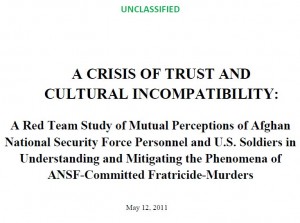How Many Ways Out of Afghanistan?
[youtube]http://www.youtube.com/watch?v=n92AZIlMmsQ[/youtube]
Ain’t but one way out baby, Lord I just can’t go out that door.
The long-stated “mission” for NATO forces in Afghanistan has been to train Afghan security forces so that they can take responsibility for the nation’s security as NATO forces are withdrawn by the end of 2014. But with most joint operations involving both US and Afghan forces now suspended due to the rapid increase in green on blue killings, that goal seems unobtainable since training is mostly suspended and the high rate of attrition means that the overall size of the ANSF will shrink rapidly. Articles this week from Reuters and the New York Times indicate that major media are now beginning to realize the impossibility of meeting this objective. Reuters brings us details on a green on blue killing from August 27, while the Times goes into detail on what the training program now looks like.
Reuters provides suggestions that the Afghan National Army member responsible for the attack on August 27 was recruited by the Taliban before he joined the ANA. Whether he was Taliban or not, the poor vetting leading to the perpetrator being in the ANA highlights the extent of the problems with the current Afghan forces:
Interviews with Afghan officials suggest that Welayat Khan was not properly vetted. He was admitted to the force seven months before the attack, despite presenting a fake birth certificate and having gotten a flimsy recommendation from a commander who vouched for him simply because the two men were ethnic Pashtuns, according to Afghan sources speaking on condition of anonymity.
might be your man I don’t know
Reuters is not buying the military’s claim that vetting will be better in the future, even though there appears to be no thought given removing the many thousands of current force members who shouldn’t be there:
The Pentagon is promising better vetting of Afghan recruits like Welayat Khan, and NATO last week announced it was scaling back cooperation with Afghans to reduce risk to Western troops. That includes Anders’ unit, stationed at Combat Outpost Xio Haq in Laghman province, in eastern Afghanistan, which, for the moment, has halted joint operations.
But it’s unclear whether the United States or NATO or the Afghan government forces they’re training will be able to stop the next Welayat Khan before he strikes.
In its description of what training has become, the Times describes a day of “training” that is nothing short of farce:
Advisers flew into Bad Pakh last month to teach the Afghans how to load wounded soldiers into an American medevac helicopter. Time permitting, they also planned mortar practice.
But when the Americans flew out 10 hours later, the training day had gone much like three previous ones held here in the past two months: the helicopter never showed. It was either down for maintenance or called away for a more pressing mission. The advisers never got a clear answer why.
Mortar practice also had to be scratched when it turned out the Afghans were missing the sight for their sole mortar tube.
Even more telling is that the Times even points out how the military has resorted to outright lies to present an illusion of progress in training (I previously addressed this particular lie): Read more →

